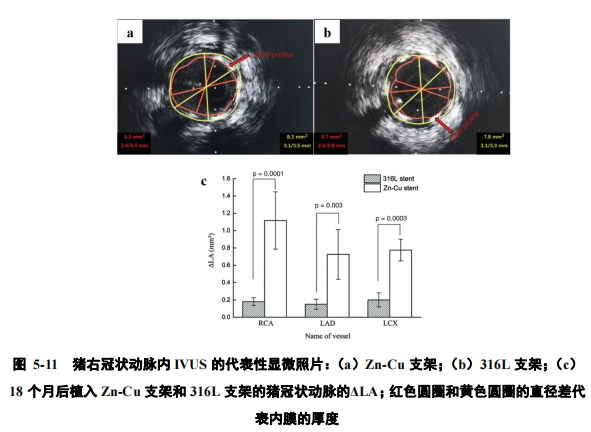
(a)Zn-Cu 支架;(b)316L 支架;(c)18 个月后植入 Zn-Cu 支架和 316L 支架的猪冠状动脉的ΔLA;红色圆圈和黄色圆圈的直径差代表内膜的厚度 。图 5-11(a)和(b)分别为 Zn-Cu 组和 316L SS 组在支架植入段中部捕获的管 腔图像。图 5-11 显示,Zn-Cu 支架和 316L 支架均未引起严重的支架内再狭窄。Zn-Cu 支架和 316L 支架均被内皮细胞覆盖,图中红色轮廓线和黄色轮廓线的直径差代表内膜的厚度。Zn-Cu 支架和 316L 支架植入的血管内膜平均厚度均为 0.5mm。 由图 5-11(c)可知,在 18 个月时 Zn-Cu 支架组在 RCA、LAD 和 LCX 中的的平均ΔLA 分别为 1.12 mm2、0.73 mm2和 0.78 mm2;316L SS 支架组 RCA、LAD 和
LCX 中的平均ΔLA 分别为 0.18 mm2、0.15 mm2和 0.20 mm2。在每种血管上,Zn-Cu支架组的ΔLA 均高于 316L SS 支架组,且差异具有统计学意义(p <0.05)。这表明Zn-Cu 支架的降解可以促进支架植入段血管正常生理搏动的恢复。血管正常生理搏动的恢复被认为是随着对血管的限制的解除而发生的[26]。恢复
可以恢复重要的血管功能,如畅通的血管运动,这对控制血流和压力至关重要[55]。永久支架置入引起的冠状动脉血管运动障碍将持续终生,而可降解支架的脉动性恢复是其显著优势之一。
(A) Zn-Cu stent; (b) 316L stent; (c) ΔLA of porcine coronary artery implanted with Zn-Cu stent and 316L stent 18 months later; the diameter difference between the red circle and the yellow circle represents the thickness of the intima . Figure 5-11 (a) and (b) are the luminal images captured in the middle of the stent implantation section in the Zn-Cu group and 316L SS group, respectively. Figure 5-11 shows that neither the Zn-Cu stent nor the 316L stent caused serious intra-stent restenosis. Both the Zn-Cu scaffold and the 316L scaffold are covered by endothelial cells. The diameter difference between the red contour line and the yellow contour line in the figure represents the thickness of the intima. The average thickness of the intima of the Zn-Cu stent and 316L stent implanted is 0.5mm. It can be seen from Figure 5-11(c) that the average ΔLA in RCA, LAD and LCX of the Zn-Cu stent group at 18 months were 1.12 mm2, 0.73 mm2 and 0.78 mm2, respectively; the 316L SS stent group RCA, LAD and
The average ΔLA in LCX is 0.18 mm2, 0.15 mm2, and 0.20 mm2, respectively. On each type of blood vessel, the ΔLA of the Zn-Cu stent group was higher than that of the 316L SS stent group, and the difference was statistically significant (p <0.05). This indicates that the degradation of the Zn-Cu stent can promote the recovery of the normal physiological pulsation of the blood vessel in the implanted segment of the stent. The restoration of the normal physiological pulsation of blood vessels is believed to occur as the restriction on blood vessels is lifted [26]. recover
It can restore important vascular functions, such as unobstructed vascular movement, which is essential for controlling blood flow and pressure [55]. The coronary vascular dyskinesia caused by permanent stent placement will last a lifetime, and the pulsatile recovery of the degradable stent is one of its significant advantages.